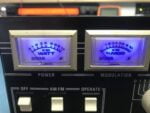Bremi BRL210 Repair & Blue LED Meter Lamp Mod
 This Bremi BRL210 linear amplifier came to me with the top off, and it’s owner showing me one of the input resistors hanging off the PCB in a burnt state, and the other also slightly charred.
This Bremi BRL210 linear amplifier came to me with the top off, and it’s owner showing me one of the input resistors hanging off the PCB in a burnt state, and the other also slightly charred.
The cause of the damage to these resistors appeared to be from over enthusiastic use of RF power being put into the Bremi linear amp. Obviously, with one resistor hanging on for dear life by only one of it’s leads, it’s needless to say, the linear wasn’t working.
 After giving the PCB a really good clean with Isopropanol Alcohol, the two 2 watt resistors were removed and replaced with new 5 watt resistors.
After giving the PCB a really good clean with Isopropanol Alcohol, the two 2 watt resistors were removed and replaced with new 5 watt resistors.
The new resistors have been mounted away from the PCB to assist in cooling, and with a bit of luck, the higher power rating may help alleviate future charring of them.
An amount of re-soldering was also carried out across the rest of the PCB as there appeared to be quite a bit of ageing, probably caused by the heating and cooling of the Bremi linear amp while in use over the years.
 The owner requested that blue LED’s be placed behind the front panel meters to replace the original lamps that had already failed.
The owner requested that blue LED’s be placed behind the front panel meters to replace the original lamps that had already failed.
A quick check of the schematic diagram revealed that the panel lamps were supplied with approximately 15 volts AC.
 As LED’s require a significantly lower voltage, it was calculated that a resistor of 2KΩ would be required to reduce the current through the LED’s sufficiently.
As LED’s require a significantly lower voltage, it was calculated that a resistor of 2KΩ would be required to reduce the current through the LED’s sufficiently.
To make the modification neatly, a small cut in the meter PCB was made to the trace that supplies the voltage to the original lamps. A 2.2KΩ resistor was placed across the cut in the trace.
 It was decided not to install any rectification diodes, but instead, to use pairs of LED’s connected back-to-back, IE: anode to cathode and cathode to anode.
It was decided not to install any rectification diodes, but instead, to use pairs of LED’s connected back-to-back, IE: anode to cathode and cathode to anode.
This method of connection allows one LED to conduct and illuminate on one half of the AC cycle, and the other LED to conduct and illuminate on the other half of the cycle, thus allowing the complete AC cycle to flow through each LED in turn.
Unfortunately, due to the illumination properties of the LED’s slight shadowing can be seen on the panel meters. In use this really isn’t a major problem.